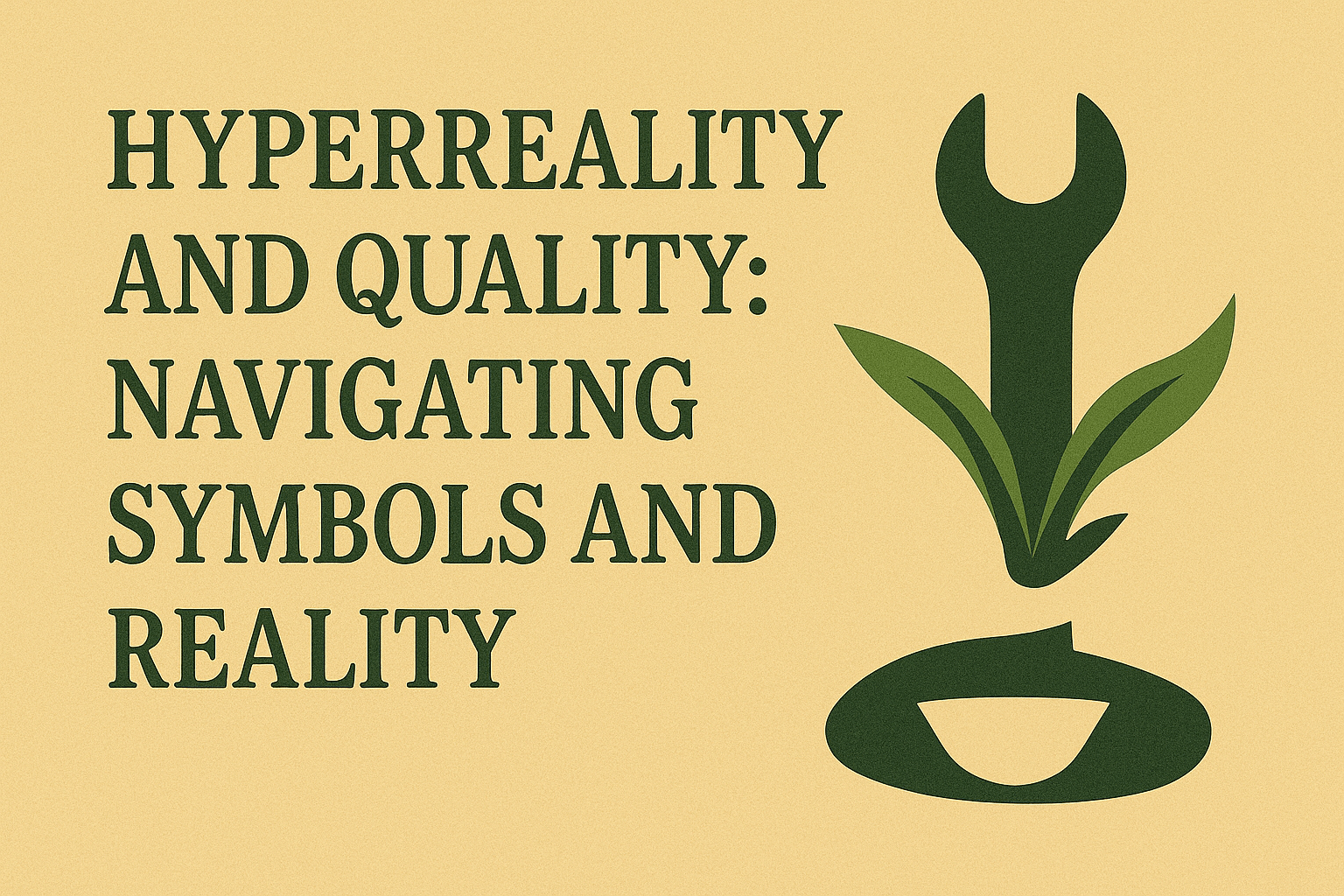Examining the concept of hyperreality and its implications for understanding quality and reality. Definition of hyperreality, its relationship with the MoQ, and the influence of symbols and simulations on perception.
The concept of hyperreality, introduced by the French sociologist and philosopher Jean Baudrillard, delves into the increasingly blurred line between reality and its representations. Hyperreality is a condition where the distinction between reality and the simulation of reality becomes indistinguishable, resulting in a world where symbols and simulations take precedence over the actual. This article explores hyperreality’s implications for understanding quality and reality, its relationship with Robert M. Pirsig’s Metaphysics of Quality (MoQ), and the influence of symbols and simulations on our perception.
Defining Hyperreality
Hyperreality is characterized by the prevalence of images, signs, and symbols that replace or surpass the real objects they represent. In a hyperreal world, these representations become more significant than the actual entities, creating a reality that is hyperreal, a reality created through simulations that have no direct connection to the real world.
- Simulacra and Simulation: Baudrillard’s concept of simulacra refers to copies or representations that either bear no relation to any reality or create a perceived reality that replaces the original. These simulations generate hyperreality, a realm where the image or symbol is more real to people than the physical reality itself.
- Media and Technology: The proliferation of media and technology plays a crucial role in creating hyperreality. Advertisements, television, the internet, and virtual reality are all mediums that construct and propagate hyperreal experiences, shaping our perceptions and interactions.
The Metaphysics of Quality (MoQ) and Hyperreality
Robert M. Pirsig’s Metaphysics of Quality provides a philosophical framework that places quality as the foundational reality. Quality, according to Pirsig, is an intrinsic value that transcends the traditional subject-object dichotomy. Exploring hyperreality through the lens of MoQ offers insights into how quality can be understood in a world dominated by symbols and simulations.
- Quality Beyond Representation: In the MoQ, quality is a primary reality that cannot be fully captured through representations. Hyperreality challenges this by suggesting that our perceptions of quality are increasingly mediated through symbols and simulations. The MoQ reminds us that while representations can guide us, they are not substitutes for the actual experience of quality.
- Static and Dynamic Quality in Hyperreality: Pirsig’s distinction between static and dynamic quality can help navigate hyperreality. Static quality represents the structured and stable aspects of life, while dynamic quality embodies change and creativity. In a hyperreal world, static quality can be seen in the repetitive and predictable nature of simulations, whereas dynamic quality emerges when individuals engage critically with these representations and seek deeper, more authentic experiences.
- Perception and Reality: Hyperreality influences how we perceive quality by shaping our realities through simulations. The MoQ encourages us to critically evaluate these perceptions and seek experiences that reflect genuine quality, beyond mere symbols and simulations.
Influence of Symbols and Simulations on Perception
Symbols and simulations have a profound impact on our perception of reality and quality. Understanding this influence is crucial for navigating a hyperreal world.
- Mediated Experiences: In hyperreality, many of our experiences are mediated through screens and digital interfaces. These mediated experiences can create a disconnect between individuals and the physical world, altering our sense of quality and authenticity. For example, a virtual tour of a museum might provide visual information but lacks the tangible and sensory engagement of being physically present.
- Consumer Culture: Hyperreality is deeply embedded in consumer culture, where advertising and branding create idealized images that often overshadow the actual products. This can lead to a distorted perception of quality, where the value is placed on the brand or image rather than the inherent qualities of the product itself.
- Virtual Identities: Online personas and virtual identities are constructed through social media and virtual worlds, creating hyperreal representations of the self. These identities often highlight curated aspects of life, influencing how individuals perceive their own and others’ quality of life. This phenomenon can result in unrealistic expectations and comparisons, impacting self-esteem and satisfaction.
- Critical Engagement: To navigate hyperreality, it is essential to engage critically with symbols and simulations. This involves questioning the authenticity and source of representations, seeking direct and unmediated experiences of quality, and valuing intrinsic qualities over superficial images.
Balancing Hyperreality with Authentic Experience
Navigating hyperreality requires a balance between engaging with representations and seeking authentic experiences that reflect true quality.
- Mindful Consumption: Practicing mindful consumption of media and technology helps in discerning quality. By being selective about the content we engage with and critically evaluating its impact on our perception, we can mitigate the influence of hyperreality.
- Direct Engagement: Prioritizing direct, unmediated experiences fosters a deeper connection with reality. Activities such as spending time in nature, face-to-face interactions, and hands-on projects provide opportunities to experience quality firsthand, beyond the realm of simulations.
- Critical Thinking: Cultivating critical thinking skills allows individuals to analyze and interpret symbols and representations more effectively. By understanding the motives and contexts behind simulations, we can better navigate the complexities of hyperreality.
- Embracing Dynamic Quality: Embracing dynamic quality involves being open to change, creativity, and genuine engagement. It means seeking out new experiences, challenging static perceptions, and valuing the journey of discovery and growth.
Conclusion
The concept of hyperreality challenges our understanding of quality and reality, as symbols and simulations increasingly shape our perceptions. By examining hyperreality through the lens of Robert M. Pirsig’s Metaphysics of Quality, we can navigate the complexities of a world where representations often overshadow the real. Recognizing the influence of symbols and simulations on our perception encourages a critical approach, balancing mediated experiences with authentic engagement. Embracing both static and dynamic quality allows us to appreciate the richness of reality and the true essence of quality, beyond the hyperreal.
